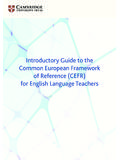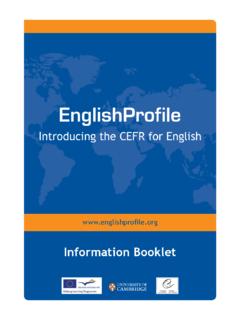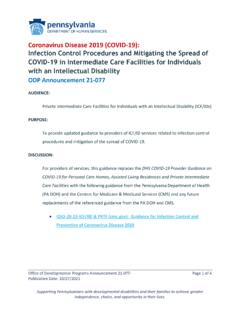Transcription of Introductory Guide to the Common European Framework of ...
1 Introductory Guide to the Common European Framework of reference (CEFR). for English Language Teachers What is the Common European Framework of reference ? The Common European Framework of reference gives you a detailed description of learner level by skill, in a language-neutral format. It is a useful reference document for school directors, syllabus designers, teachers, teacher trainers and proficient learners. The CEFR has three broad bands A, B and C. Very loosely, you can see these as similar to Beginner, intermediate and Advanced though the CEFR levels are more precise than these terms (and calls them Basic, Independent, and Proficient). Each of those bands is divided into two, giving us six main levels . Level General description Cambridge English Exam Highly proficient can use English C2 Mastery very fluently, precisely and sensitively Cambridge English: Proficiency in most contexts Proficient user Effective Able to use English fluently and flexibly C1 Operational in a wide range of contexts Cambridge English: Advanced Proficiency Can use English effectively, with some Independent B2 Vantage fluency, in a range of contexts Cambridge English: First/First for Schools user Cambridge English: Preliminary/.
2 Can communicate essential points B1 Threshold and ideas in familiar contexts Preliminary for Schools Can communicate in English within Cambridge English: Key/Key for Schools A2 Waystage Basic user a limited range of contexts Cambridge English: Flyers Can communicate in basic English Cambridge English: Movers A1 Breakthrough with help from the listener Cambridge English: Starters Why do we need the CEFR? Even among teachers of the same language in similar contexts there can be a lot of variety in what is meant by terms like beginner', intermediate ' or advanced'. This variability increases significantly across different languages, in different countries, with different age ranges of learners, etc. The CEFR makes it easier for all of us to talk about language levels reliably and with shared understanding.
3 Is it just about levels ? The CEFR has been very significant in language learning and teaching because its impact goes beyond merely describing learner levels . It has underpinned a particular approach to language learning as the one most commonly recommended or expected in language teaching today. This approach is based on the notion of communicative proficiency the increasing ability to communicate and operate effectively in the target language. The descriptions of levels are skills-based and take the form of Can Do statements, as in the examples below. These descriptions of ability focus on communicative purpose and make for a very practical approach, which looks at what people can do rather than on specific linguistic knowledge.
4 2 Cambridge University Press 2013. Examples of Can Do statements from the CEFR. Can describe in simple terms aspects of his/her background, immediate environment and matters in areas of immediate need. [A2, Global Scale]. Can understand enough to follow extended speech on abstract and complex topics beyond his/her own field, though he/she may need to confirm occasional details, especially if the accent is unfamiliar. [C1, Listening]. Can understand a wide range of long and complex texts, appreciating subtle distinctions of style and implicit as well as explicit meaning. [C2, Reading]. Can write personal letters and notes asking for or conveying simple information of immediate relevance, getting across the point he/she feels to be important.
5 [B1, Written interaction]. Can use stock phrases ( That's a difficult question to answer ) to gain time and keep the turn whilst formulating what to say. [B2, Turntaking]. What is it used for? The CEFR is used for many different practical purposes: developing syllabuses creating tests/exams marking exams evaluating language learning needs designing courses developing learning materials describing language policies continuous/self-assessment teacher training programmes We will look later at how it can be useful to you as a teacher. Cambridge University Press 2013 3. Progressing through the CEFR levels The CEFR helps us understand the different levels of language proficiency. It also helps us understand how learners progress through the levels .
6 The Association of Language Testers in Europe (ALTE) of which Cambridge English Language Assessment is a founding member estimates that learners typically take the following guided learning hours to progress between levels . Guided learning hours' means time in lessons as well as tasks you set them to do. You will notice that it takes longer to progress a level as learners move up the scale. Of course, learners will vary in how long they take depending on many factors. CEFR Level Guided Learning Hours C2 Approximately 1,000 1,200. C1 Approximately 700 800. B2 Approximately 500 600. B1 Approximately 350 400. A2 Approximately 180 200. A1 Approximately 90-100. This means that many learners will follow more than one course to progress from one level to the next.
7 We can also use the +' to indicate the top half of a level. For example, B1+' means the top half of the B1. range. You will find this convention followed on Cambridge course books. We are also working on a project to define in more detail the linguistic knowledge typically mastered at each CEFR level for English. This programme is called English Profile and there's more information on this later in this booklet. This more precise information helps teachers get a better idea of how to break down the learning for each CEFR level into different classes within their school or college. 4 Cambridge University Press 2013. The CEFR Global Scale You will find the Global Scale is a useful starting point: Can understand with ease virtually everything heard or read.
8 Can summarise information from different spoken and written sources, reconstructing arguments and accounts in a coherent presentation. C2 Can express him/herself spontaneously, very fluently and precisely, differentiating finer shades of meaning even in more complex situations. Can understand a wide range of demanding, longer texts, and recognise implicit meaning. Can express him/herself fluently and spontaneously without much obvious searching for expressions. C1 Can use language flexibly and effectively for social, academic and professional purposes. Can produce clear, well-structured, detailed text on complex subjects, showing controlled use of organisational patterns, connectors and cohesive devices. Can understand the main ideas of complex text on both concrete and abstract topics, including technical discussions in his/her field of specialisation.
9 Can interact with a degree of fluency and spontaneity that makes regular interaction with native B2 speakers quite possible without strain for either party. Can produce clear, detailed text on a wide range of subjects and explain a viewpoint on a topical issue giving the advantages and disadvantages of various options. Can understand the main points of clear standard input on familiar matters regularly encountered in work, school, leisure, etc. Can deal with most situations likely to arise whilst travelling in an area where the language is spoken. B1 Can produce simple connected text on topics, which are familiar, or of personal interest. Can describe experiences and events, dreams, hopes & ambitions and briefly give reasons and explanations for opinions and plans.
10 Can understand sentences and frequently used expressions related to areas of most immediate relevance ( very basic personal and family information, shopping, local geography, employment). Can communicate in simple and routine tasks requiring a simple and direct exchange of A2 information on familiar and routine matters. Can describe in simple terms aspects of his/her background, immediate environment and matters in areas of immediate need. Can understand and use familiar everyday expressions and very basic phrases aimed at the satisfaction of needs of a concrete type. Can introduce him/herself and others and can ask and answer questions about personal details A1 such as where he/she lives, people he/she knows and things he/she has.






